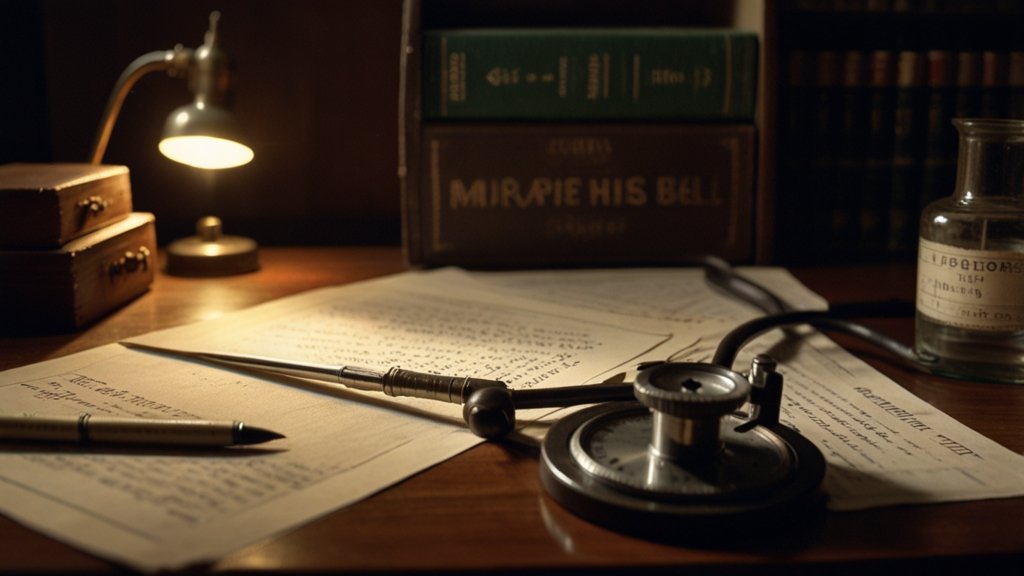Imagine the hushed sterility of a 1930s hospital ward. A physician moves between beds, her trained eye noting subtle symptoms invisible to others. Now, picture that same sharp clinical mind dissecting a murder scene, spotting the telltale signs of a poisoner’s hand or the staged clumsiness of a “perfect” accident. This unique fusion of medicine and mystery wasn’t fiction; it was the real life of Josephine Bell, the physician-turned-author who brought chilling authenticity to the Golden Age of detective fiction. While names like Christie and Sayers often dominate the conversation, Josephine Bell carved her own distinct niche, wielding her medical knowledge like a scalpel to craft some of the era’s most ingenious and unsettling plots.
From Doctor’s Bag to Writer’s Desk: The Unlikely Genesis of a Crime Queen
Born Doris Bell Collier in 1897, Bell’s path seemed destined for medicine. Graduating from University College Hospital, London, she practiced medicine for nearly two decades. This wasn’t just background colour; it was foundational. Her intimate understanding of the human body, pharmacology, pathology, and the psychology of both patients and colleagues became the bedrock of her writing career, which began in earnest after her marriage to Dr. Norman Dyer Ball in the late 1930s.
- The Medical Lens: Bell didn’t just set murders in hospitals or involve doctors; she thought like a physician when constructing her crimes. Her killers often exploited medical knowledge or settings – tampering with medications, mimicking natural disease, or using esoteric poisons requiring specific expertise to detect.
- Authentic Atmosphere: Her descriptions of hospitals, surgeries, nursing homes, and country practices weren’t clichéd backdrops. They pulsed with the authentic tensions, hierarchies, and ethical dilemmas of mid-20th-century healthcare. Readers could smell the antiseptic and feel the weight of a doctor’s responsibility.
Introducing Dr. David Wintringham: Bell’s Enduring Detective
While Bell penned numerous standalone novels brimming with suspense, her most famous creation is undoubtedly Dr. David Wintringham. Debuting in Murder in Hospital (1937), Wintringham wasn’t a flamboyant genius or a quirky amateur. He was a general practitioner – solid, observant, deeply human, and grounded in the same medical reality Bell knew so well.
- The GP Detective: Wintringham’s strength lay in his everydayness and his medical acumen. He noticed the things others missed – a minor symptom that didn’t fit, a medication error that couldn’t be accidental, the subtle signs of psychological distress masked by physical complaints. He solved crimes through careful observation, logical deduction rooted in science, and a profound understanding of human nature gained at countless bedsides.
- The Series Appeal: The Wintringham series resonated because it felt plausible. Readers believed in a country doctor stumbling upon murder and using his specific skills to unravel it. The series spanned decades, offering a comforting yet intelligent presence throughout Bell’s prolific career.
Josephine Bell vs. Golden Age Contemporaries: A Unique Prescription
| Feature | Josephine Bell | Agatha Christie (e.g., Poirot/Marple) | Dorothy L. Sayers (Lord Peter Wimsey) |
|---|---|---|---|
| Detective | Dr. David Wintringham (GP) | Hercule Poirot (Consultant), Miss Marple (Amateur) | Lord Peter Wimsey (Aristocratic Amateur) |
| Key Strength | Medical Authenticity & Plausible Poisoning | Intricate Puzzle Plots, Misdirection | Literary Depth, Character Development |
| Setting | Often Hospitals, Surgeries, Rural Practices | Country Houses, Villages | Varied (High Society, Advertising etc.) |
| Method Focus | Poison, Medical Manipulation, Psychological Insight | Diverse (Poison, Blunt Force etc.) | Diverse, often complex mechanics |
| Tone | Grounded, Procedural, Psychological | Puzzle-Centric, Cozy (Marple) | Intellectual, Social Commentary |
Also Read: King Von Autopsy Insights You Need to Know
Founding Pillar: The Crime Writers’ Association (CWA)
Josephine Bell wasn’t just a writer; she was a crucial community builder. In 1953, alongside author John Creasey, she became a founding member of the Crime Writers’ Association (CWA). This organisation, vital in promoting the genre and supporting writers, saw Bell rise to become its Chair – a testament to the respect she commanded among her peers. Her leadership helped solidify the CWA’s role in fostering talent and celebrating crime fiction’s literary merits.
The Bell Signature: Poison, Psychology, and Plausible Peril
Ask any crime aficionado about Josephine Bell, and one word invariably surfaces: poison. Her medical expertise made her a virtuoso in this deadly art.
- Beyond Arsenic: While classics like arsenic featured, Bell explored less common, more insidious toxins – substances that mimicked natural illnesses, had delayed effects, or required specific antidotes known only to the initiated. Her poisons weren’t just plot devices; they were characters in themselves, demanding medical knowledge to understand and detect.
- Methodical Murder: Beyond poison, Bell’s murders were often characterised by their cold, calculated precision. Think insulin overdoses, air embolisms, rigged medical equipment, or the subtle manipulation of a vulnerable patient’s condition. Her killers frequently used knowledge as a weapon, exploiting trust within medical or familial settings.
- Psychological Depth: Bell understood that motive wasn’t always grand passion or greed. Her work often delved into the darker corners of the human psyche – professional jealousy among colleagues, the crushing burden of caring for a difficult relative, hidden shame, or the desperate desire to maintain respectability at any cost. Her criminals often felt chillingly ordinary, making their actions all the more disturbing.
The Enduring Prescription: Josephine Bell’s Legacy
Publishing steadily from the 1930s into the early 1980s (her final novel, A Well-Known Face, appeared in 1980), Josephine Bell left an indelible mark. Her work paved the way for the modern medical thriller and the procedural novel that prioritises forensic and psychological accuracy.
- Influence on the Genre: Writers like P.D. James (who also explored medical settings and psychological complexity) and the legion of contemporary forensic thriller authors owe a debt to Bell’s pioneering blend of authentic medical detail and suspenseful plotting. She proved that the science of death could be as compelling as the act itself.
- Rediscovery: While perhaps less ubiquitous in mainstream consciousness than Christie, Bell is a revered figure among Golden Age enthusiasts and scholars. Her books are increasingly sought after by collectors and republished by houses dedicated to classic crime, introducing her unique talents to new generations of readers hungry for intelligent, character-driven mysteries grounded in chilling reality.
Why Josephine Bell Still Matters Today
In an age saturated with forensics-driven TV shows and hyper-detailed thrillers, Josephine Bell’s work retains a powerful relevance. She reminds us that:
- Authenticity is Timeless: Genuine expertise, woven seamlessly into narrative, creates enduring believability and tension.
- The Mundane Can Be Terrifying: The greatest horrors often lurk in familiar places – the local surgery, the family home, the trusted caregiver.
- Character is Key: Even amidst intricate plots, understanding the why behind the crime, the psychology of both perpetrator and investigator, remains paramount.
- Observation Solves Cases: Bell championed the power of noticing the small details, the inconsistencies that others overlook – a lesson valuable both in fiction and life.
Josephine Bell took the tools of her first profession – observation, diagnosis, an understanding of life’s fragility – and applied them masterfully to her second. She didn’t just write detective stories; she conducted meticulous autopsies on human motives and societal pressures, delivering prescriptions for suspense that continue to captivate. Her legacy is a testament to the power of bringing real-world knowledge to the art of fiction, crafting mysteries that are as intellectually satisfying as they are genuinely unsettling.
You May Also Read: Decoding Sky Bri Net Worth and Financial Journey
FAQs
What was Josephine Bell’s real name?
Her real name was Doris Bell Collier. She wrote under the pen name Josephine Bell.
Is Dr. David Wintringham based on Josephine Bell herself?
While Wintringham is a GP like Bell was, he’s a fictional character. However, he undoubtedly channels her deep medical knowledge, observational skills, and understanding of general practice, making him a strong reflection of her professional perspective.
Why is Josephine Bell particularly famous for using poison in her novels?
Her extensive medical training gave her detailed knowledge of pharmacology, toxicology, and how substances affect the human body. This allowed her to devise intricate, plausible, and often quite subtle poisoning methods that felt authentic and required medical insight to solve, setting her apart from many contemporaries.
How many books did Josephine Bell write?
She was incredibly prolific, publishing nineteen standalone novels and a long-running series featuring Dr. David Wintringham over nearly five decades. The exact total number of Wintringham novels is around 20, bringing her overall output to nearly 40 crime novels.
What role did Josephine Bell play in the Crime Writers’ Association (CWA)?
She was a founding member of the CWA in 1953 and later served as its Chair. This highlights her significant role not just as a writer, but as a key organizer and respected figure within the British crime writing community.
Are Josephine Bell’s books still in print?
While not all are readily available in mainstream bookshops, many of her novels, particularly the Dr. Wintringham series and key standalones, are being republished by specialist publishers focusing on classic crime fiction (like Agora Books, Moonstone Press). They are also commonly found in secondhand bookstores and online retailers.
What makes Josephine Bell different from Agatha Christie?
While both are Golden Age greats, Bell’s defining characteristic is her deep, authentic use of medical knowledge to drive plots, especially concerning poisons and psychological manipulation within medical or care settings. Her detective, Wintringham, is a working GP, offering a more grounded, procedural feel compared to Christie’s often more eccentric or amateur sleuths. Her focus leaned more towards psychological realism and plausible method derived from her profession.











